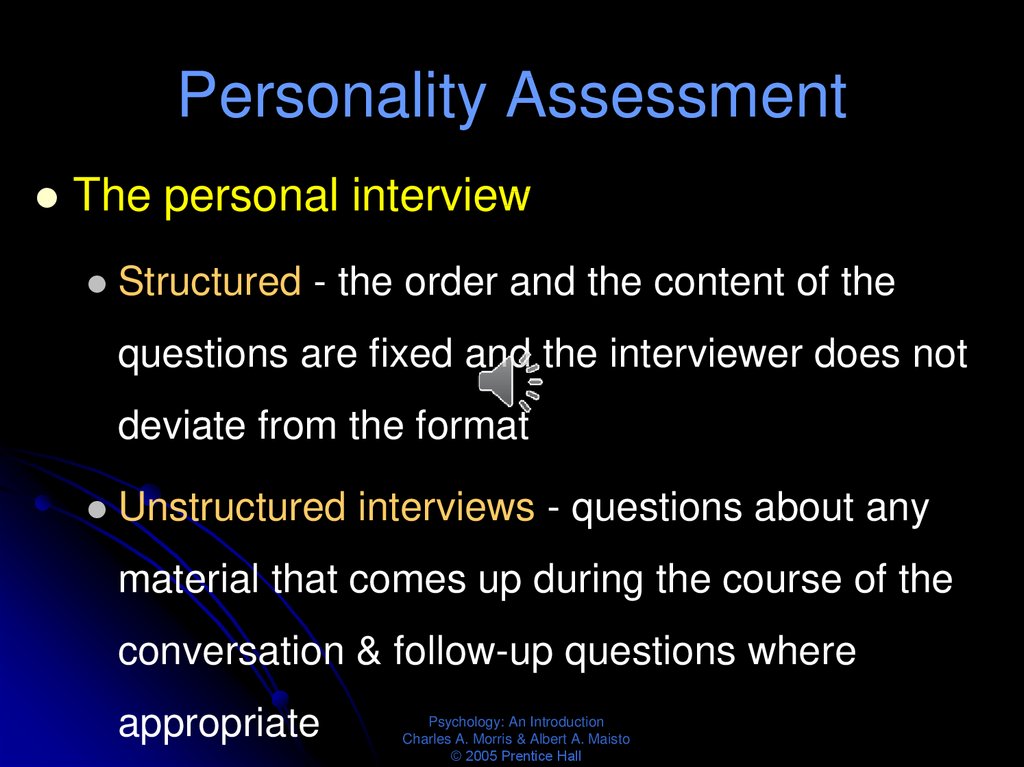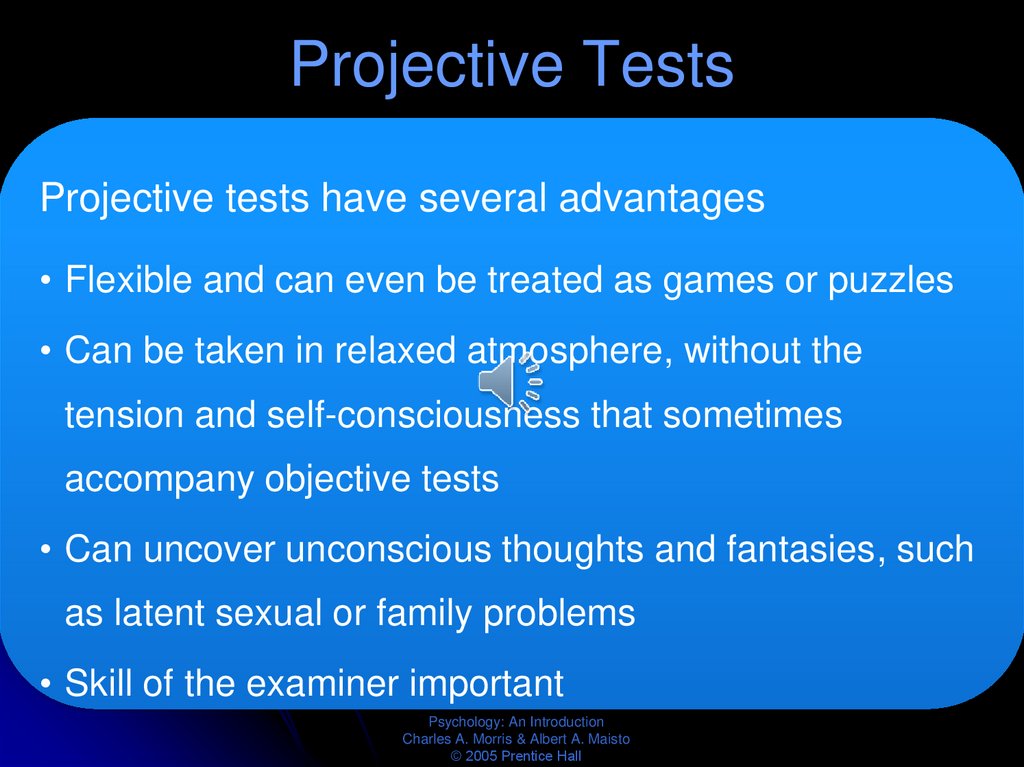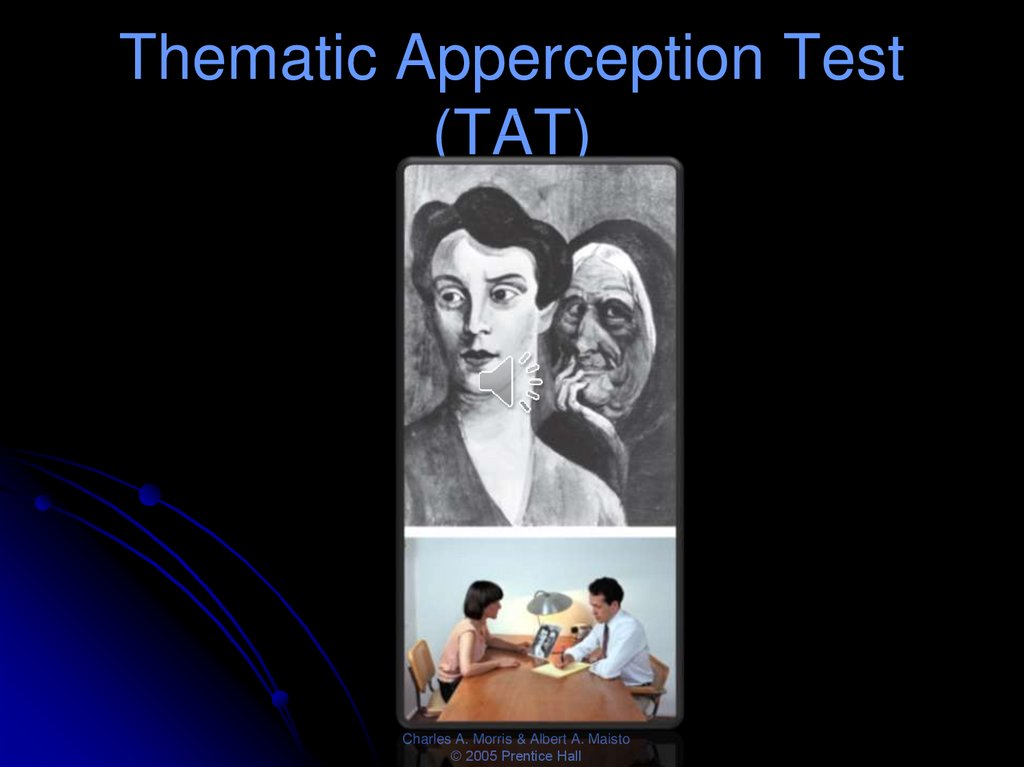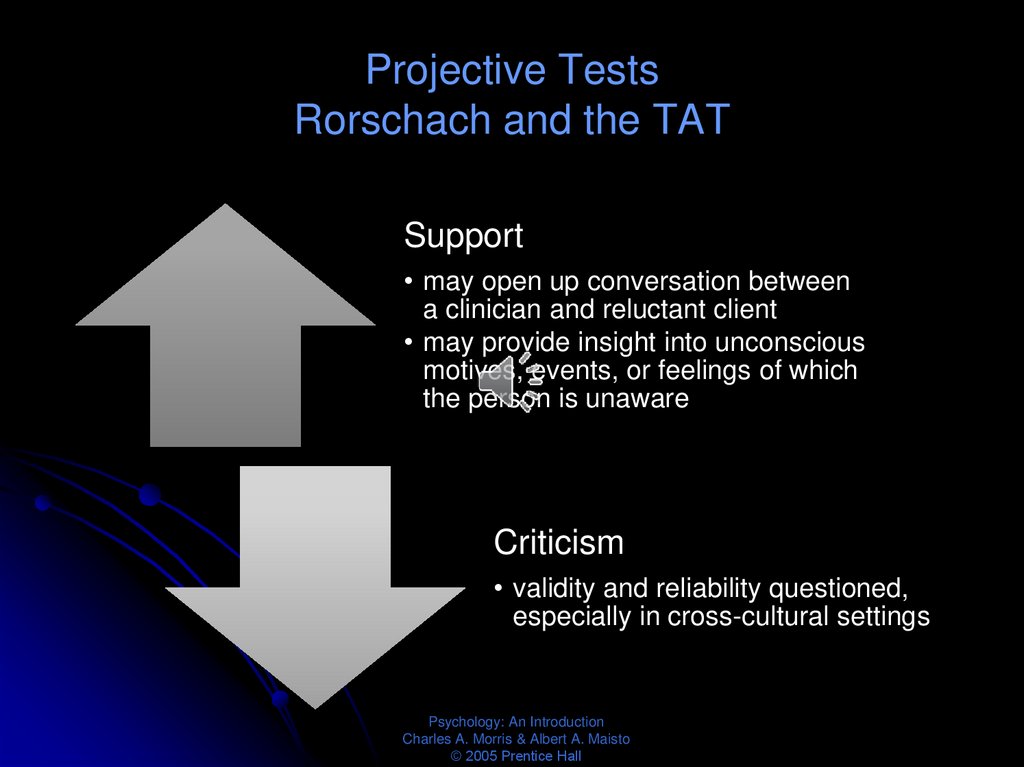Similar presentations:
Personality theories
1. Personality
Psychology: An IntroductionCharles A. Morris & Albert A. Maisto
© 2005 Prentice Hall
2. Humanistic Personality Theories
Asserts the fundamental goodness of people &their constant striving toward higher levels of
functioning
Believes that life is process of opening ourselves to
the world around us and experiencing joy in living
Focus is on the present and future, rather than past
Psychology: An Introduction
Charles A. Morris & Albert A. Maisto
© 2005 Prentice Hall
3. HUMANISTIC PERSONALITY THEORIES
Assumptions• Stress potential for growth and change in present, rather
than dwelling on past actions or feelings
• Believe given reasonable life conditions, people will
develop in desirable directions
• Abraham Maslow’s theory of hierarchy of needs leads to
self-actualization
Psychology: An Introduction
Charles A. Morris & Albert A. Maisto
© 2005 Prentice Hall
4. Carl Rogers
According to Carl Rogers (1902-1987), men andwomen develop their personalities in the service of
positive goals
Every organism is born with certain innate capacities,
capabilities, or potentialities− “a sort of genetic blueprint, to
which substance is added as life progresses”
The goal of life is to fulfill this genetic blueprint; to become
the best of whatever each of us is inherently capable of
becoming
Rogers called this biological push toward fulfillment the
actualizing tendency, i.e. realization of our biological
potential
Psychology: An Introduction
Charles A. Morris & Albert A. Maisto
© 2005 Prentice Hall
5. Carl Rogers
Human beings also form images of themselves, orself-concepts.
Striving to fulfill our self-concept, our conscious
sense of who we are, is the self-actualizing
tendency - the attempt to fulfill our conscious sense
of who we are and what we want to do w/ our lives
When our self-concept is closely matched with our
inborn capacities, we become a fully functioning
person.
Psychology: An Introduction
Charles A. Morris & Albert A. Maisto
© 2005 Prentice Hall
6. Carl Rogers
Fully functioning persons are ‘on track’ toactualization
Actualizing and self-actualizing tendencies
shape development
According to Rogers, people tend to
become more fully functioning if they are
brought up with unconditional positive
regard.
Psychology: An Introduction
Charles A. Morris & Albert A. Maisto
© 2005 Prentice Hall
7. Carl Rogers
Unconditional positive regardThe experience of being treated with warmth,
respect, acceptance, and love regardless of
their own feelings, attitudes, and behaviors –
helps the actualization process
Fully functioning people were usually raised
with unconditional positive regard
Psychology: An Introduction
Charles A. Morris & Albert A. Maisto
© 2005 Prentice Hall
8. Carl Rogers
Conditional positive regardOften parents and other adults offer children
what Rogers called conditional positive regard
acceptance
and love that are dependent
upon the child’s behaving in certain ways
and on fulfilling certain conditions*
limits
the process
Psychology: An Introduction
Charles A. Morris & Albert A. Maisto
© 2005 Prentice Hall
9. Carl Rogers
Fully functioning people are self-directedThey are also open to experience − to their own
feelings as well as to the world and other people
around them
Psychology: An Introduction
Charles A. Morris & Albert A. Maisto
© 2005 Prentice Hall
10. Evaluating Humanistic Theories
The basic tenets of humanistic theory aredifficult to test scientifically
Some view these theories as overly optimistic
and that they ignore the nature of human evil
Some argue that humanistic view lead to
narcissism and self-centeredness and reflects
Western values
However, research on humanist therapies,
particularly Rogers’s client-centered therapy,
has shown they do promote self-acceptance.
Psychology: An Introduction
Charles A. Morris & Albert A. Maisto
© 2005 Prentice Hall
11. TRAIT THEORIES
Personality traits• dimensions or
characteristics such as
dependency,
aggressiveness, and
sociability on which
people differ in
distinctive ways
• approximately 200 stable
and enduring personality
characteristics
Trait theories
• focus on differences in
personality traits
Psychology: An Introduction
Charles A. Morris & Albert A. Maisto
© 2005 Prentice Hall
12. Trait Theories
Categorizing and describing individualdifferences in personality
Can be inferred from how the person behaves
People differ on personality traits such as
dependency, aggressiveness, or anxiety
Development of trait theories
Early approaches identified thousands of traits
Psychology: An Introduction
Charles A. Morris & Albert A. Maisto
© 2005 Prentice Hall
13. TRAIT THEORIES
Cattelfactor analysis used to
find that traits cluster in
groups
sixteen traits account
for complexity of human
personality
later added additional
seven traits
Psychology: An Introduction
Charles A. Morris & Albert A. Maisto
© 2005 Prentice Hall
14. TRAIT THEORIES
EysenckTRAIT THEORIES
argued personality
could be reduced
to three basic
dimensions:
emotional stability,
introversionextraversion,
and
psychoticism
Psychology: An Introduction
Charles A. Morris & Albert A. Maisto
© 2005 Prentice Hall
15. The Big Five
Costa and McCraeThe Big Five
Big Five personality dimensions, or five-factor model
personality consists of five basic dimensions: “extraversion”, “agreeableness”,
“conscientiousness”, “emotional stability-neuroticism” , and “culture, intellect, and openness
to experience”
these five dimensions seem to capture most salient dimensions of human personality
= thought to be central to describing personality
model may have some important real-world applications related to employment, socialization
and school performance
Psychology: An Introduction
Charles A. Morris & Albert A. Maisto
© 2005 Prentice Hall
16. TABLE 10–1 The “Big Five” Dimensions of Personality
Psychology: An IntroductionCharles A. Morris & Albert A. Maisto
© 2005 Prentice Hall
17. Are the “Big Five” Traits Universal?
Evidence point to the presence of the bigfive traits across cultures
Findings of twin studies suggest a genetic
basis for traits
Psychology: An Introduction
Charles A. Morris & Albert A. Maisto
© 2005 Prentice Hall
18. Evaluating Trait Theories
Support• Has considerable commonsense appeal
• Scientifically easier to study personality
traits than to study things like selfactualization, unconscious motives
• Well supported by research
Criticism
• Primarily descriptive: not causal
• Traits may not capture the complexity of
human behavior
• Traits represent statistical averages of
populations rather than individuals
• Disagreement over minimum number of
traits needed to fully describe variety of
human behavior
Psychology: An Introduction
Charles A. Morris & Albert A. Maisto
© 2005 Prentice Hall
19. PERSONALITY ASSESSMENT
Testingpersonality is
much like testing
intelligence
In both cases,
trying to measure
something
intangible and
invisible
So what might
constitute a good
test?
Psychology: An Introduction
Charles A. Morris & Albert A. Maisto
© 2005 Prentice Hall
20. PERSONALITY ASSESSMENT
Specialdifficulties
in
measuring
personality
• best vs. typical
behavior*
• confounding
measurement
variables**
Psychology: An Introduction
Charles A. Morris & Albert A. Maisto
© 2005 Prentice Hall
21. PERSONALITY ASSESSMENT
For the intricate task of measuring personality, psychologists usefour basic tools:
personal interview
direct observation of behavior
objective tests
projective tests
Psychology: An Introduction
Charles A. Morris & Albert A. Maisto
© 2005 Prentice Hall
22. Personality Assessment
The personal interviewStructured - the order and the content of the
questions are fixed and the interviewer does not
deviate from the format
Unstructured interviews - questions about any
material that comes up during the course of the
conversation & follow-up questions where
appropriate
Psychology: An Introduction
Charles A. Morris & Albert A. Maisto
© 2005 Prentice Hall
23. The Personal Interview
generallyunstructured
with follow up
questions
used in clinical
settings to
learn and to
help diagnose
require
attention to
personal
variables
Unstructured
Interviews
Psychology: An Introduction
Charles A. Morris & Albert A. Maisto
© 2005 Prentice Hall
24. The Personal Interview
more relies onstructured
interviews
used when
conducting
systematic
research
comparable
information from
everyone
interviewed
Structured
interview
Psychology: An Introduction
Charles A. Morris & Albert A. Maisto
© 2005 Prentice Hall
elicit information
about sensitive
topics that might
not come up in
unstructured
interview
25. Personality Assessment
Direct observationObservers watch people’s behavior firsthand
Systematic observation allows psychologists to look at
aspects of personality as they are expressed in real life
Ideally, the observers’ unbiased accounts of behavior
paint an accurate picture of that behavior, but an observer
runs the risk of misinterpreting the true meaning of an act*
Direct observation or videotape can capture person /
environment interaction**
Psychology: An Introduction
Charles A. Morris & Albert A. Maisto
© 2005 Prentice Hall
26. Direct Observation
providesinformation on
range of
behaviors
allows view of
how situation
and environment
influence
behavior
behavior
watched
firsthand
reduces bias;
still may be
misinterpretation
Direct
observation
Psychology: An Introduction
Charles A. Morris & Albert A. Maisto
© 2005 Prentice Hall
27. Personality Assessment
Objective testsTests administered and scored in a standardized way
Most widely used tools for assessing personality
Sixteen
Personality Factor Questionnaire (16PF)
Minnesota
Multiphasic Personality Inventory (MMPI-2)
Entire reliance on self-report
Familiarity with test format may affect their responses to it
Psychology: An Introduction
Charles A. Morris & Albert A. Maisto
© 2005 Prentice Hall
28. Objective Tests: Trait Theorists
Cattell: SixteenPersonality Factor
Questionnaire
NEO-PI-R yields
scores for each trait
Costa and McCrae:
NEO-PI-R
primary use assess
the personality of a
normal adult
Trait theorists favor
objective tests
may be useful in
some clinical
settings
Minnesota
Multiphasic
Personality
Inventory (MMPI-2)
Psychology: An Introduction
Charles A. Morris & Albert A. Maisto
© 2005 Prentice Hall
aid in diagnosing
psychiatric
disorders
29.
Psychology: An IntroductionCharles A. Morris & Albert A. Maisto
© 2005 Prentice Hall
30.
Psychology: An IntroductionCharles A. Morris & Albert A. Maisto
© 2005 Prentice Hall
31.
Psychology: An IntroductionCharles A. Morris & Albert A. Maisto
© 2005 Prentice Hall
32. Projective Tests
Psychodynamic theorists prefer projective testsof personality
After looking at an essentially meaningless graphic
image or at a vague picture, the test taker explains
what the material means
The tests offer no clues regarding the “best way” to
interpret material or to complete sentence
Psychology: An Introduction
Charles A. Morris & Albert A. Maisto
© 2005 Prentice Hall
33. Projective Tests
Projective tests have several advantages• Flexible and can even be treated as games or puzzles
• Can be taken in relaxed atmosphere, without the
tension and self-consciousness that sometimes
accompany objective tests
• Can uncover unconscious thoughts and fantasies, such
as latent sexual or family problems
• Skill of the examiner important
Psychology: An Introduction
Charles A. Morris & Albert A. Maisto
© 2005 Prentice Hall
34. Projective Tests
Rorschachtest
Thematic
Apperception
Test (TAT)
Psychology: An Introduction
Charles A. Morris & Albert A. Maisto
© 2005 Prentice Hall
35. Inkblots used in the Rorschach projective test
Psychology: An IntroductionCharles A. Morris & Albert A. Maisto
© 2005 Prentice Hall
36. Thematic Apperception Test (TAT)
Psychology: An IntroductionCharles A. Morris & Albert A. Maisto
© 2005 Prentice Hall
37. Projective Tests Rorschach and the TAT
Support• may open up conversation between
a clinician and reluctant client
• may provide insight into unconscious
motives, events, or feelings of which
the person is unaware
Criticism
• validity and reliability questioned,
especially in cross-cultural settings
Psychology: An Introduction
Charles A. Morris & Albert A. Maisto
© 2005 Prentice Hall





































 psychology
psychology english
english








